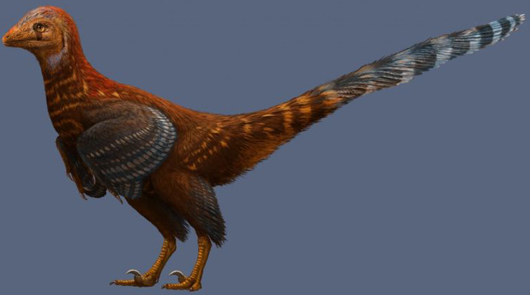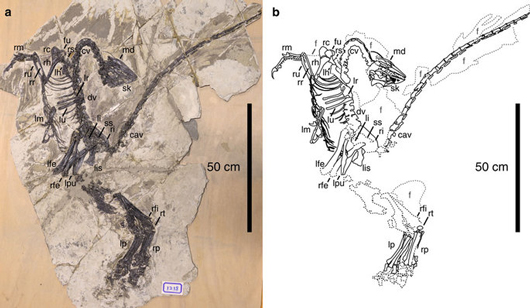Jianianhualong tengi – Feathered Troodontid Shows Mosaic Evolution
A turkey-sized, feathered troodontid dinosaur that once roamed the forests of north-eastern China some 125 million years ago, is helping palaeontologists to piece together the evolution of characteristics that led to the true birds. In addition, the new dinosaur named Jianianhualong tengi (pronounced: jay-any-an-who-long ten-gee) provides direct evidence for the presence of pennaceous feathers in an unquestionable troodontid Theropod. J. tengi is also the earliest known troodontid discovered to date.
Feathered Like a Modern Bird but Flightless Jianianhualong tengi
Picture credit: Julius T. Csotonyi
Asymmetrical Pennaceous Feathers
The Mesozoic-aged strata of Liaoning Province (China) has yielded a myriad of spectacular theropod dinosaur fossils, providing palaeontologists with a unique insight into the forest dwelling fauna and flora. Liaoning is famous for its spectacular fossils of maniraptoran dinosaurs, the clade of theropod dinosaurs that includes the birds (Aves) and their nearest dinosaur relatives.
However, fossils of the very closest types of dinosaur to the Aves, those in the clade Eumaniraptora (also known as the Paraves) – dromaeosaurids and troodontids, have had scientists in a bit of a flap. The discovery of Jianianhualong tengi from the Yixian Formation of Baicai Gou in Yixian County, Liaoning, will help palaeontologists to better understand the development of anatomical features as well as feathers, that led to the evolution of birds.
Definitely a member of the Troodontidae
Previously, the troodontid species described from China had caused extensive debate amongst scientists. Their exact position in the dinosaur family tree was controversial. Jianianhualong tengi is unquestionably a troodontid and by definition, very closely related to birds. It had large, prominent arm and leg feathers as well as a frond-like integumentary covering on the tail. This distribution pattern of feathers and their asymmetrical shape is similar to that seen in other basal members of the Paraves, such as the dromaeosaurid Microraptor. The researchers highlight this is the first time that such definitive bird-like features have been identified in what is undoubtedly, a member of the Troodontidae.
Photograph and Line Drawing of Holotype Specimen (J. tengi)
Picture credit: Nature Communications
Demonstrating Mosaic Evolution
Jianianhualong tengi demonstrates mosaic evolution, the process where parts of an animal’s skeleton changes without simultaneously affecting other portions. For example, Jianianhualong has anatomical features that are transitional between long-armed basal troodontids and derived short-armed ones, shedding new light on troodontid character evolution. The feathers are similar to those seen in Archaeopteryx and Anchiornis and this confirms that asymmetrical, pennaceous feathers were probably ancestral to the Paraves.
Evidence of Asymmetrical Plumage in Jianianhualong tengi
Picture credit: Nature Communications
The picture above shows (a) feathers over dorsals, (b) feathers attached to anterior caudals, the base of the tail (c) an asymmetrical tail feather, (d) a line drawing of an asymmetrical tail feather, (e) tail frond and (f) negative LSF (laser-stimulated fluorescence) image of tail frond. All scale bars equal two centimetres.
The researchers, which include Professor Phil Currie (University of Alberta), report their findings in the academic journal “Nature Communications”
Jianianhualong tengi
The new scientific paper on Jianianhualong helps palaeontologists to comprehend how these types of dinosaurs and their close avian relatives evolved, but there is another question to answer. Why would dinosaurs like Jianianhualong evolve asymmetrical flight feathers if they were not used for flight?
A spokesperson from Everything Dinosaur speculated:
“Perhaps asymmetrical feathers helped this 1.2-metre-long dinosaur to run quicker through the forest. There is no evidence to suggest that Jianianhualong or that it was arboreal.”
Professor Currie commented:
“As the closest relatives to birds, troodontids are certainly one of the most interesting groups of dinosaurs, and any time you find a feathered dinosaur and discover a new species is pretty cool. With mosaic features, we’re looking for the answer as to why there’s a combination of primitive and advanced features.”
Its discovery is highly significant in reconstructing both the skeletal and integumentary evolution of troodontids, and the more inclusive paravians, whereas, with other reported troodontids from the Jehol Biota such as Sinovenator (S. changii), Mei long and Sinusonasus magnodens their assignment to the Troodontidae remains uncertain.
What’s in a Name?
The genus name honours Jianianhua, he Chinese company that helped fund this research and the word “long” is the Chinese Pinyin for “dragon”. The trivial name honours Ms Fangfang Teng, who secured the specimen for study.









Leave A Comment